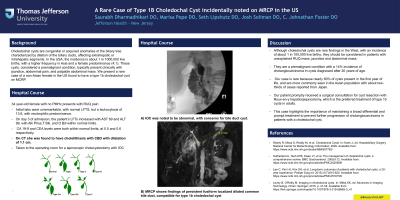Monday Poster Session
Category: Biliary/Pancreas
P1791 - Rare Type 1B Choledochal Cyst in a Non-Asian Female: A Case Report
Monday, October 28, 2024
10:30 AM - 4:00 PM ET
Location: Exhibit Hall E

Has Audio
- SD
Saurabh Dharmadhikari, DO
Thomas Jefferson Health
Newark, DE
Presenting Author(s)
Saurabh Dharmadhikari, DO1, Marisa Pope, DO2, Seth Lipshutz, DO3, Joshua Soliman, DO2, C Johnathan Foster, DO4
1Thomas Jefferson Health, Newark, DE; 2Jefferson Health, Washington Township, NJ; 3Jefferson Health, Ivyland, PA; 4Jefferson Health, Cherry Hill, NJ
Introduction: Choledochal cysts are congenital or acquired anomalies of the biliary tree characterized by dilation of the biliary ducts, affecting extrahepatic or intrahepatic segments. In the USA, the incidence is about 1 in 1000,000 live births, with a higher frequency in Asia and a female predominance (4:1). These cysts, considered a premalignant condition, typically present clinically with jaundice, abdominal pain, and palpable abdominal mass. We present a rare case of a non-Asian female in the US found to have a type 1b choledochal cyst on MCRP.
Case Description/Methods: A 34 y/o female with no medical history presented with complaints of RUQ pain. Initial labs were unremarkable, with normal LFTS, but a leukocytosis of 13.6, with neutrophilic predominance. On day 3 of admission, the patient's LFTs increased with AST 69 and ALT 99, with Alk Phos,T Bili, and D Bili within normal limits. CA 19-9 and CEA levels were both within normal limits, at 0.5 and 0.6 respectively. On CT she was found to have cholelithiasis with CBD with dilatation of 1.1 cm. The patient then underwent laparoscopic cholecystectomy with IOC. IOC was noted to be abnormal, with concerns for bile duct cyst. After IOC, the patient underwent MRCP which revealed findings of persistent fusiform localized dilated common bile duct, compatible for a type 1b choledochal cyst. GI recommended surgical resection to mitigate the risk of future malignancy. After surgery, the patient was discharged with instructions to follow up with general surgery.
Discussion: Although choledochal cysts are rare findings in the West, with an incidence of about 1 in 100,000 live births, they should be considered in patients with unexplained RUQ mass, jaundice and abdominal mass. They are a premalignant condition with a 14% incidence of cholangiocarcinoma in cysts diagnosed after 20 years of age. Our case is rare because nearly 60% of cysts present in the first year of life, and are more commonly seen in the Asian population with about two-thirds of cases reported from Japan. Our patient promptly received a surgical consultation for cyst resection with Roux-en-y hepaticojejunostomy, which is the preferred treatment of type 1b cysts in adults. This case highlights the importance of maintaining a broad differential and prompt treatment to prevent further progression of cholangiocarcinoma in patients with a choledochal cyst.
Disclosures:
Saurabh Dharmadhikari, DO1, Marisa Pope, DO2, Seth Lipshutz, DO3, Joshua Soliman, DO2, C Johnathan Foster, DO4. P1791 - Rare Type 1B Choledochal Cyst in a Non-Asian Female: A Case Report, ACG 2024 Annual Scientific Meeting Abstracts. Philadelphia, PA: American College of Gastroenterology.
1Thomas Jefferson Health, Newark, DE; 2Jefferson Health, Washington Township, NJ; 3Jefferson Health, Ivyland, PA; 4Jefferson Health, Cherry Hill, NJ
Introduction: Choledochal cysts are congenital or acquired anomalies of the biliary tree characterized by dilation of the biliary ducts, affecting extrahepatic or intrahepatic segments. In the USA, the incidence is about 1 in 1000,000 live births, with a higher frequency in Asia and a female predominance (4:1). These cysts, considered a premalignant condition, typically present clinically with jaundice, abdominal pain, and palpable abdominal mass. We present a rare case of a non-Asian female in the US found to have a type 1b choledochal cyst on MCRP.
Case Description/Methods: A 34 y/o female with no medical history presented with complaints of RUQ pain. Initial labs were unremarkable, with normal LFTS, but a leukocytosis of 13.6, with neutrophilic predominance. On day 3 of admission, the patient's LFTs increased with AST 69 and ALT 99, with Alk Phos,T Bili, and D Bili within normal limits. CA 19-9 and CEA levels were both within normal limits, at 0.5 and 0.6 respectively. On CT she was found to have cholelithiasis with CBD with dilatation of 1.1 cm. The patient then underwent laparoscopic cholecystectomy with IOC. IOC was noted to be abnormal, with concerns for bile duct cyst. After IOC, the patient underwent MRCP which revealed findings of persistent fusiform localized dilated common bile duct, compatible for a type 1b choledochal cyst. GI recommended surgical resection to mitigate the risk of future malignancy. After surgery, the patient was discharged with instructions to follow up with general surgery.
Discussion: Although choledochal cysts are rare findings in the West, with an incidence of about 1 in 100,000 live births, they should be considered in patients with unexplained RUQ mass, jaundice and abdominal mass. They are a premalignant condition with a 14% incidence of cholangiocarcinoma in cysts diagnosed after 20 years of age. Our case is rare because nearly 60% of cysts present in the first year of life, and are more commonly seen in the Asian population with about two-thirds of cases reported from Japan. Our patient promptly received a surgical consultation for cyst resection with Roux-en-y hepaticojejunostomy, which is the preferred treatment of type 1b cysts in adults. This case highlights the importance of maintaining a broad differential and prompt treatment to prevent further progression of cholangiocarcinoma in patients with a choledochal cyst.
Disclosures:
Saurabh Dharmadhikari indicated no relevant financial relationships.
Marisa Pope indicated no relevant financial relationships.
Seth Lipshutz indicated no relevant financial relationships.
Joshua Soliman indicated no relevant financial relationships.
C Johnathan Foster indicated no relevant financial relationships.
Saurabh Dharmadhikari, DO1, Marisa Pope, DO2, Seth Lipshutz, DO3, Joshua Soliman, DO2, C Johnathan Foster, DO4. P1791 - Rare Type 1B Choledochal Cyst in a Non-Asian Female: A Case Report, ACG 2024 Annual Scientific Meeting Abstracts. Philadelphia, PA: American College of Gastroenterology.
